Trick or Treat: The Linguistic Mysteries of Halloween

It’s that spooky time of year again when the streets come alive with witches, goblins, and pumpkins. Halloween, a holiday celebrated worldwide, has a fascinating linguistic background, not to mention a plethora of Halloween-themed vocabulary. In this blog post, we’ll delve into the origins of Halloween, explore some intriguing linguistic tidbits, and have some fun with the language of this eerie holiday.
The Origins of Halloween
Halloween’s roots can be traced back to the ancient Celtic festival of Samhain (pronounced ‘sow-in’). Samhain marked the end of the harvest season and the beginning of winter when the boundary between the living and the dead blurred. It was believed that spirits returned to the earthly realm during Samhain. As a result, people would light bonfires and wear costumes to ward off roaming ghosts.
The word “Halloween” itself has linguistic roots in the Christian calendar. It is a contraction of “All Hallows’ Eve,” which refers to the evening before All Hallows’ Day (also known as All Saints’ Day). Over time, All Hallows’ Eve transformed into Halloween, reflecting the celebration’s fusion of ancient Celtic traditions with Christian influences.
Linguistic Trick-or-Treat: Halloween Vocabulary
Now, let’s have some linguistic fun with Halloween-related vocabulary:
- Jack-o’-Lantern: This term derives from the Irish folktale of “Stingy Jack,” who was said to have trapped the devil in a deal. The jack-o’-lantern, a carved pumpkin with a candle inside, symbolises Jack’s wandering spirit.
- Ghoul: The word “ghoul” has Arabic origins. In Arabian folklore, a “ghul” is an evil spirit or demon that robs graves and feeds on corpses. This word made its way into English, adding to the spooky vocabulary.
- Witch: The word “witch” has an Old English root, “wicca,” which referred to a male witch or wizard. Later, “witch” became the term for both genders and the stereotypical image of a witch as a woman took hold.
- Candy Corn: Everyone’s favourite Halloween candy has a self-explanatory name. It’s shaped like corn kernels and comes in vibrant colours, making it the perfect seasonal treat.
- Trick or Treat: The phrase “trick or treat” exemplifies the playful nature of Halloween. It essentially means, “Give us a treat, or we might play a prank on you!” The word “treat” has Old English origins, while the notion of playing “tricks” can be traced back to the mischievous spirits of Samhain.
- Boo!: The classic Halloween exclamation to scare someone has uncertain origins. Some suggest it comes from the Latin word “boas,” meaning to shout, while others link it to the Middle English word “bo!” for “to make a loud, frightening noise.”
Halloween Around the World
Halloween is celebrated in various forms around the world, with each culture adding its own linguistic and cultural flavours. In Mexico, for instance, they celebrate Dia de los Muertos (Day of the Dead), a holiday with deep linguistic significance, focusing on remembering and honouring deceased loved ones.
In Germany, children go door-to-door for sweets during the “Rübengeistern” festival, and in China, the Hungry Ghost Festival pays homage to ancestors. These cultural variations demonstrate the linguistic diversity and richness of Halloween worldwide.
In Conclusion: Happy Halloween!
As you carve your jack-o’-lanterns, don your spookiest costumes, and enjoy the eerie delights of Halloween, remember that this holiday’s linguistic roots run deep. It’s a time when we celebrate the blurred lines between the living and the supernatural, and our diverse languages and cultures contribute to the enchantment of this special day.
So, whether you’re saying “trick or treat” in English, “Süßes oder Saures” in German, or “¡Queremos Halloween!” in Spanish, the magic of Halloween transcends borders, uniting us in a shared love for all things spooky and spectacular. Happy Halloween to all, and may your linguistic adventures be filled with treats, not tricks!
